Michael Hudson's "Super Imperialism: The Economic Strategy of Imperial America" - First written in 1972, it was updated in a 2003 edition that's every bit as relevant now - thus this review focusing on Hudson's new preface, introduction, and detailed account of the book's theme.
He revisited it in his 2008-09 Project Censored award- winning article titled: "Economic Meltdown - The 'Dollar Glut' is What Finances America's Global Military Build-up" in which he explains the following - the "inter-related dynamics" of:
-- "surplus (US) dollars pouring into the rest of the world for yet further financial speculation and corporate takeovers;"
-- global central banks "recyl(ing) these dollar inflows (into) US Treasury bonds to finance the federal US budget deficit; and most important (but most suppressed in the US media),"
-- "the military character of the US payments deficit and the domestic federal budget deficit."
In other words, the global "dollar glut" finances US corporate takeovers, speculative excesses creating bubbles and global economic crises, America's reckless spending, foreign wars, hundreds of bases worldwide, "military build-up," and culture of militarism and belligerence overall at the expense of democratic freedoms, beneficial social change, and human and civil rights.
In softer form, it's what former US diplomat, advisor, father of Soviet containment, and dove compared to others at that time George Kennan believed should be America's post-WW II foreign policy. In his February 1948 "Memo PPS23, he stated:
"....we have 50% of the world's wealth but only 6.3% of its population. (It makes us) the object of envy and resentment. Our real task in the coming period is to devise a pattern of relationships (to let us) maintain this position of disparity without positive detriment to our national society. To do so we will have to dispense with all sentimentality and daydreaming; and our attention will have to be concentrated everywhere on our immediate national objectives. We need not deceive ourselves that we can afford today the luxury of altruism and world benefaction....
We should dispense with the aspiration to 'be liked' or to be regarded as the repository of a high-minded international altruism....We should (stop talking about) unreal objectives such as human rights, the raising of the living standards, and democratization. The day is not far off when we are going to have to deal in straight power concepts. The less we are hampered by idealistic slogans (ideas and practices), the better."
Yet Kennan advocated diplomacy over force in contrast to Paul Nitze, Dean Atcheson and other Truman and succeeding administration officials favoring hardline militarism, future wars, and National Security Council Report 68 (NSC-68) policies to contain the Soviet Union. In 1962, nuclear disaster nearly resulted. The threat remains, more menacingly than ever by "forc(ing) foreign central banks to bear the costs of America's expanding military empire" through recycling their dollars into US Treasuries - something the mass media call "showing their faith in US economic strength."
Hudson refers to a "sinister dynamic," not involving consumers or private investors, but central banks putting "their money" in US Treasuries, but "it is not 'their money' at all. They are sending back the dollars that foreign exporters and other recipients turn over to their central banks for domestic currency."
"When the US payment deficit pumps dollars into foreign economies, these banks (have) little option except to buy US Treasury bills and bonds which the Treasury spends on financing an enormous, hostile military build-up to encircle (today's) major dollar-recyclers China, Japan and Arab OPEC oil producers" - essentially a process by which they finance their own endangerment.
Up to now it's continued, but, given the reckless dollar glut in recent months, with less enthusiasm by bigger buyers and hints of a possible end game or at least less buying than previously - mostly among BRIC (Brazil, Russia, India and China) and OPEC countries but other emerging economies as well getting more interdependent on themselves than on America.
In his 2002 preface, Hudson noted that "the US Treasury (pursued the same balance-of-payment) 'benign neglect' (strategy as) it did thirty years" earlier. In 1971, it "caused a global crisis when its $10 billion (level) led to a 10 per cent dollar devaluation." Now it's hundreds of billions annually and still high during the current economic crisis when exports and imports are lower.
Earlier and especially now, if Europe and Asia let the dollar deflate, their exporters will be disadvantaged at a time they can least afford it. So they're forced to "support the dollar's exchange rate by recycling their surplus dollars back to the United States" by buying US Treasuries.
Sooner or later, it's a losing proposition, especially in today's climate with the Federal Reserve sacrificing dollar strength to bail out Wall Street and trying to keep long rates low to contain borrowing costs. Yet the greater the dollar erosion, the more losses foreign investors will incur and less likely they'll tolerate more by buying bad assets.
So far, however, they're still recycling their dollar inflows to fund America's budget deficit and global militarism - something Hudson calls a "Free Lunch in the form of compulsory foreign loans to finance US Government policy."
Even so, they have no say over US policies, yet America and international lending agencies, like the IMF and World Bank, "use their dollar claims" on indebted nations to enforce Washington Consensus diktats. Independent-minded states face sanctions, isolation, coups or wars if they refuse.
Until Nixon closed the gold window in August 1971, America couldn't run unlimited balance-of-payments deficits. However without gold convertibility, it's continued for nearly 40 years along with protectionist policies through generous subsidies to US exporters - most notably to agribusiness. As a result, Hudson sees international tensions growing for the next generation, perhaps even greater now given America's reckless monetarism and perpetual wars.
His book "provid(es) the background for US - European and US - Asian financial relations by explaining how (post-1971) the US Treasury-bill standard came to provide America with a Free Lunch." Also how the IMF promoted debtor nations' capital flight and the World Bank supported "foreign trade dependency on US farm exports...."
The early 1970s dollar crisis and balance-of-payments deficits seem small compared to today. Yet the "Treasury-bill standard (frees) the US economy from (doing) what American diplomats (force on) other debtor nations (with) payments deficits: impose austerity to restore balance in its international payments. The United States alone has been free to pursue domestic expansion and foreign diplomacy with hardly a worry about the balance-of-payment consequences." No other nation has that luxury.
Post-WW II, Washington made other countries dependent on America, something it eschewed after WW I, staying isolationist instead to pursue internal development.
In the 1970s, emerging nations proposed a New International Economic Order (NIEO) through the UN Conference on Trade and Development to promote their own trade and other concerns. It "originated as a response to America's aggressive world economic diplomacy, and how US strategy has provided other nations with a learning curve that they may follow in pressing their own national and regional interests."
The more reckless and belligerent America becomes, the more incentive they have to try - and in greater alliance, with BRIC country partners, may have a greater chance for success.
Introduction
Post-WW II, on the pretext of national security, America pursued "world power....and economic advantage as perceived by American strategists quite apart from the profit motive of private investors."
After WW I, it achieved world creditor status from its "unprecedented terms (in extending) armaments and reconstruction loans to its wartime allies." In 1917, it entered the war late when it felt staying out would "entail at least an interim economic collapse (the result of) American bankers and exporters (getting) stuck with uncollectible loans to Britain and allies." So it joined the Triple Entente as an associate, not a full partner, to protect its $12 billion investment.
Post-war, America was the world's major creditor - but one "to foreign governments with which it felt little brotherhood" and no obligation to stabilize world finance and trade. Unlike its post-WW II policy, it didn't extend loans to foreign countries so they could finance their US-owed debt. Nor did it open its markets to foreign imports. It wanted Europe's empires dissolved, their military spending cut, their wealth "to flow out and their prices to fall" - the idea being in this way to re-establish world payments equilibrium, a very unrealistic notion, but many leading Europeans embraced it. It didn't work and made repayment of foreign debts impossible.
The "world economy emerged from World War I shackled with debts far beyond its ability to pay," except by "borrow(ing) funds from private lenders in the creditor nation to pay the creditor-nation government."
A more enlightened policy would have turned "other countries into (US) economic satellites." But America eschewed European imports, and US investors preferred its own outperforming stock market. On trade and finance, US policies "impelled European countries to withdraw from the world economy and turn within."
America's isolationism prevented it from collecting its foreign debts. "Its status as world creditor proved ultimately worthless as the world broke into nationalist units," and sought independence from foreign trade and payments.
Washington pursued isolationism, thus prompting other nations to seek self-sufficiency. A bankrupt Britain convened the 1932 Ottawa Conference "to establish a system of Commonwealth tariff preferences." By the mid-1930s, Germany began preparing for war. At the same time, the Depression affected one country after another as private capital dried up while at the same time Britain and other nations had mounting debt problems. It begs the question as to why they let them get so onerous in the first place.
American Plans for a Post-WW II "Free-Trade Imperialism"
Early in the war, US officials and economists knew America would prevail and emerge as the world's dominant power. However, transitioning from war to peace needed large export volumes to stimulate economic growth and full employment. "This in turn required that foreign countries be able to earn or borrow dollars to pay" for what they got. So America supplied them through government loans and private investment.
In return, it "name(d) the terms on which" they were provided and structured the IMF and World Bank so countries could "pursue laissez faire policies by insuring adequate resources to finance the international payments imbalances," the result of opening their markets to US imports. It was thought that free trade and investment would result in "balanced international trade and payments....under US leadership."
Post-war, America was the only dominant nation intact, so it alone had enough foreign exchange to invest substantially abroad. Its commercial strength turned other economies into US satellites and assured America achieved maximum world power by:
-- having European nations let US investors buy extractive industries in their former colonies, especially Middle East oil;
-- less developed nations would supply America with raw materials rather than develop their own competitive manufacturing infrastructure;
-- they'd also buy US products and services; and
-- the resulting trade surplus would provide enough foreign exchange for US investors to buy the world's most productive resources and make America even stronger.
The goal was short-lived as:
-- America had tariffs on commodities that other nations could produce more cheaply;
-- the International Trade Organization, in place to subject all economies to the same rules, was scuttled; and
-- private US investment abroad was never enough to finance sufficient foreign purchases of US exports; IMF and World Bank loans also fell short.
America accumulated a payments surplus. It, in turn, weakened its export potential. The lesson learned was that "Beyond a point, a creditor and payment-surplus status can be decidedly uncomfortable."
At first, the enlightened solution wasn't taken - extended foreign aid for rebalancing as Congress put internal interests ahead of foreign policy.
The Cold War Pushes America's Balance-of-Payments into Deficit
Cold War strategy gave Congress an anti-communist reason to "bribe foreign governments" to fight the red menace as well as open their markets to US exporters. It got the Marshall Plan and other aid agreed on to "keep its fellow capitalist countries solvent" and not tempted to turn left. The possibility continued foreign aid for several decades.
At the same time, America's balance-of-payments reached never before attained levels and needed rebalancing "to promote foreign export markets and world currency stability." To buy US products and services, other countries needed resources to pay for them, something only Washington could arrange at a time when they weren't creditworthy.
However, what worked early on became destabilizing as America began "sink(ing) into the mire that had bankrupted every European power that experimented with colonialism." Unlike foreign investors that cut their losses when necessary, national security interests (and industries profiting from them) trump other considerations even when counterproductive. Once begun, military spending takes on a life of its own - something very apparent given its current out-of-control level and growing.
New Characteristics of America's Financial Imperialism
A growing US balance-of-payments surplus was "incompatible with continued growth in world liquidity and trade." So America had to buy more foreign products, services and capital assets than it supplied to foreign buyers. At the same time, it shifted more dollars abroad through a payments deficit, easily handled in the 1950s and 1960s as long as Washington could redeem them with gold. But that game had a limited life span as "Attempts by governments to repay their debts beyond a point extinguish(es) their monetary base."
...."international money (is also) a debt of the key-currency nation." Providing other countries with assets involves going into debt, and repaying it "extinguish(es) an international monetary asset."
By the early 1960s, America approached "the point at which its debts to foreign central banks soon would exceed the value of the Treasury's gold stock." It happened in 1964 the result of Vietnam War spending at an early stage in the conflict. Just as two world wars bankrupted Europe, Vietnam threatened the same fate for America, but it didn't curtail spending and still doesn't.
Earlier, the result was a run on gold with foreign central banks "cash(ing) in their dollar surpluses for American gold almost on a monthly basis." By March 1968, the US Treasury suspended its sales, and informally world central banks agreed to stop converting dollars into the metal. The result - the dollar gold price link was broken, and in August 1971, Nixon closed its window with an official embargo.
Henceforth, in place of gold, the US Treasury-bill (dollar-debt) standard began. No longer able to buy US gold, substituting Treasuries became the only option and "to a much lesser extent, US corporate stocks and bonds."
From then to now, foreign central banks have recycled their dollars to the US government. "Running a dollar surplus in their balance of payments became synonymous with lending (it) to the US Treasury." For its part, America borrows from other central banks and runs trade deficits. The larger they get, the greater the amount available to be loaned back, so today the volume is enormous.
For both sides, the problem is that Washington's guns and butter economy (including trillions to Wall Street) creates greater deficits and inflated spending. America's dominance is maintained, and foreign economies are obliged to finance it. Failure to support the dollar will inflate their own currencies, give US exporters a competitive edge, and ultimately let the world monetary system break down.
The "unique ability of the US Government to borrow from foreign central banks rather than from its own citizens (through taxes) is one of the economic miracles of modern times. Without it, the war-induced American prosperity of the 1960s and early 1970s would have ended quickly...."
How America's Payment Deficit Became a Source of Strength, not Weakness
It let America achieve what no earlier empires did - "a flexible form of global exploitation that controlled debtor countries by imposing Washington Consensus (diktats)." It's used the IMF, World Bank and other international lending agencies for its purposes, while the Treasury-bill standard "obliged the payments-surplus nations of Europe and East Asia to extend forced loans to the US Government." If they don't, world economies face monetary crisis.
Implications for the Theory of Imperialism
Hudson calls it a "new form of imperialism" under which America exploits other nations "via the central banks (and international lending agencies) rather than via the activities of private corporations seeking profits."
A "Super Imperialism" model "pressed foreign governments to regulate their nations' trade and investment to serve US national objectives...Washington Consensus (diktats) made aid borrowers more dependent on their creditors, worsened their terms of trade by promoting raw materials exports and grain dependency, and forestalled needed social modernization such as land reform and progressive income and property taxation."
US companies thus achieved a competitive advantage, not in the marketplace, but by Washington Consensus rules and the Bretton Woods institutions it controls - the IMF, World Bank, etc. What's good for US business benefits America overall and its Super Imperial ambitions.
Today's Source of Financial Instability Compared to the 1920s
The earlier period had a shortage of liquidity. By the early 1970s, it was in surplus, the result of the enormous volume of dollar inflows in world economies. The Korean War began shifting America's balance-of-payments from surplus to deficit. In 1971, Vietnam forced it off gold and "induced a US debtor-oriented international financial policy (with) the rest of the world" - something other nations have been trapped by ever since.
US deficits have disrupted world economies, but its character has changed. Not only does it finance US militarism, but it also "sustain(s) America's stock market and real estate bubble" while at the same time industrial America erodes. In addition, pressure is applied to privatize public enterprises to let this sector pass "into the hands of global finance capital....controlled and shaped by the Washington Consensus."
Under a "new state-capitalist form of imperialism," central banks, not industry, "are the vehicle for balance-of-payments exploitation" with the dollar as the world's reserve currency. It's Super Imperialism because one nation alone gets a Free Lunch right to benefit by getting others to finance its deficits and reckless spending.
The system's unique feature is that other countries may extract their citizens' wealth, but only America extracts theirs through the sale of its Treasury securities.
The World's Need for Financial Autonomy from Dollarization
In its relationship with client countries, America's dollarization policy imposes dependency, not self-sufficiency. It drains "the financial resources of its Dollar Bloc allies (and retards) the development of indebted third world raw-materials exporters...." But its gain isn't put to productive use. It's used instead for militarism and financialization at the expense of its former industrial strength.
It's an unsustainable system, but for other countries to break away, they'll have to renounce Chicago School alchemy, the austerity programs it imposes, and advantages it gives America in trade and other relations. It drains other nations' resources by trapping emerging economies in chronic debt and developed ones into forced buying of US Treasuries.
In return, America gets a Free Lunch. It rules as world debtor, forces other countries into creditor bondage, and threatens to bring down the global monetary system if enough of them balk. So far it's worked because Europe and Asia lack the political will to devise a "New International Economic Order" so nations producing economic gains can keep them and not let America use them to reinforce its "new kind of centralized global planning" - one based on financialization and a US Treasury securities standard, not industrial mechanisms. In WTO terms, it transfers foreign trade gains from other economies to the US, drains their resources overall, promotes dependency, not self-sufficiency, and backs it with hardline militarism and threats of systemic monetary collapse.
Eventually, exploited countries won't tolerate more "taxation without representation," a "quid without quo," a Free Lunch from "the world's payments-surplus nations." The longer America demands it by glutting world economies with dollars, the more likely disadvantaged nations will object. Hudson put it this way in his Project Censored award-winning article:
Today, "the only way a nation can block capital movements is to withdraw from the IMF, the World Bank and the World Trade Organization (WTO). For the first time since the 1950s, this looks like a real possibility, thanks to the worldwide awareness" of America's dirty game and how it harms them.
"De-Dollarization and the Ending of America's Financial-Military Empire"
In his June 14, 2009 article, Hudson explained that "Chinese President Hu Jintao, Russian President Dmitry Medvedev and other top officials of the six-nation Shanghai Cooperation Organization (SCO)" had a two-day June 15 - 16 meeting in Yekaterinburg, Russia, with Brazil attending on the 16th. SCO countries include Russia, China, Kazakhstan, Tajikistan, Kyrghyzstan, Uzbekistan with Iran, India, Pakistan and Mongolia having observer status.
The meeting's stated purpose was "to discuss mutual aid," not challenge America's financial and military empire. Yet it potentially may be pivotal by doing just that.
On June 5, Medvedev told the St. Petersburg International Economic Forum that Russia, China and India have an opportunity to "build an increasingly multipolar world order" away from America's "artificially maintained unipolar system (based on) one big centre of consumption, financed by a growing deficit, and thus growing debts, one formerly strong reserve currency, and one dominant system of assessing assets and risks."
In other words, America "makes too little and spends too much," especially with regard to its military. It also gluts the world with dollars that end up in foreign central banks. Either they recycle them into US Treasuries or "let the 'free market' force up their currency relative to the dollar - thereby pricing their exports out of world markets, creating domestic unemployment and business insolvency."
Given a choice up to now, they've had to choose the least bad alternative. "Now they want out" as Medvedev explained in St. Petersburg saying: "what we need are financial institutions of a completely new type, where particular political issues and motives, and particular countries will not dominate." How so is the question, and can it work?
"For starters, the six SCO (and other BRIC) countries intend to trade in their own currencies" to benefit by what America "until now has monopolized for itself." China's central bank governor Zhou Xiaochuan wants a new reserve currency "that is disconnected from individual nations." It was discussed in Yekaterinburg.
These and other countries see America as "a lawless nation, not only financially but also militarily." It forces its rules on others but won't abide by them itself - a practice now intolerable, and there's more.
So much of America's budget is for militarism that the Pentagon faces overstretch while the nation is so indebted it's effectively a deadbeat with amounts impossible to repay. For countries like China, the problem is especially acute given its $2 trillion holdings "denominated in yuan."
A "return to the kind of dual exchange rates common between World Wars I and II" may be the solution - "one exchange rate for commodity trade, another for capital movements and investments."
With or without these controls, "foreign nations are taking steps to avoid being the unwilling recipients of yet more dollars" that face lower valuations the more of them America prints. If SCO countries and Brazil have their way, America "no longer (will) live off the savings of others....nor have the money for unlimited military expenditures and adventures." For these nations and many others, it can't come a moment too soon.


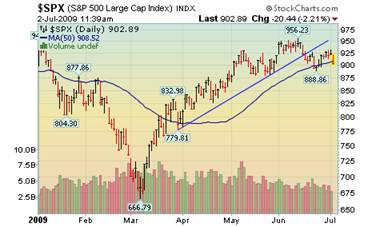 --U.S. stocks fell, sending the Standard & Poor’s 500 Index to a third straight weekly drop, as a worse-than-projected decrease in jobs added to concern that rising unemployment will prolong the recession. The S&P 500 has slumped 3.7 percent since June 12 on concern the 40 percent, three-month surge in the index outpaced prospects for a recovery in the economy and corporate profits. Next week launches earnings reports, which will reveal the extent to which hope may have overtaken reality.
--U.S. stocks fell, sending the Standard & Poor’s 500 Index to a third straight weekly drop, as a worse-than-projected decrease in jobs added to concern that rising unemployment will prolong the recession. The S&P 500 has slumped 3.7 percent since June 12 on concern the 40 percent, three-month surge in the index outpaced prospects for a recovery in the economy and corporate profits. Next week launches earnings reports, which will reveal the extent to which hope may have overtaken reality. 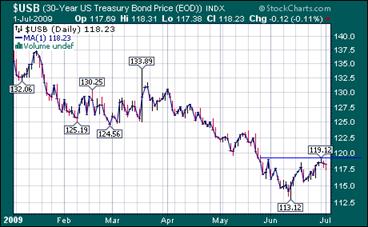 -- Treasuries gained after a government report showed the U.S. economy lost more jobs than forecast in June, fueling speculation that rising unemployment will prolong the worst recession in a half-century. The employment data supports that assertion and will likely allow policy makers to keep the borrowing rates lower for longer. Traders decreased odds that the central bank will tighten, predicting a 26 percent probability that officials will increase rates by November, down from 67 percent after last month’s jobs report.
-- Treasuries gained after a government report showed the U.S. economy lost more jobs than forecast in June, fueling speculation that rising unemployment will prolong the worst recession in a half-century. The employment data supports that assertion and will likely allow policy makers to keep the borrowing rates lower for longer. Traders decreased odds that the central bank will tighten, predicting a 26 percent probability that officials will increase rates by November, down from 67 percent after last month’s jobs report. 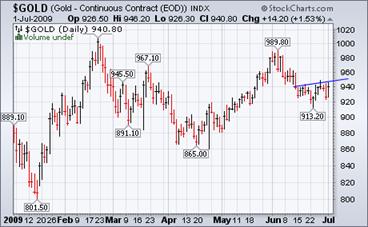 Gold
Gold 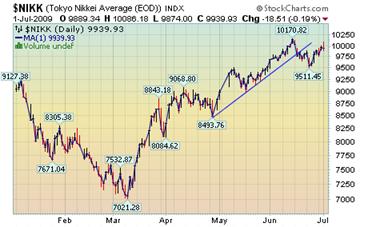 -- Japanese stocks dropped for a second day, led by banks as concern a merger will fail to produce a stronger lender drove down Aozora Bank Ltd. and Shinsei Bank Ltd. Oil producers fell on lower crude prices. The pattern in the Nikkei is similar to the S&P 500 index, which show how closely linked the two economies are. It may be safe to say that things may deteriorate from here, since the U.S. employment number took another hit today.
-- Japanese stocks dropped for a second day, led by banks as concern a merger will fail to produce a stronger lender drove down Aozora Bank Ltd. and Shinsei Bank Ltd. Oil producers fell on lower crude prices. The pattern in the Nikkei is similar to the S&P 500 index, which show how closely linked the two economies are. It may be safe to say that things may deteriorate from here, since the U.S. employment number took another hit today.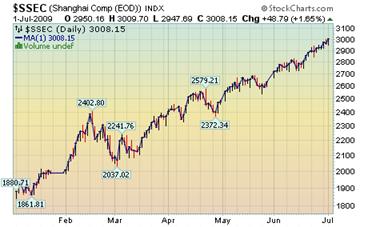 -- China’s stocks rose, driving the Shanghai Composite Index to its biggest gain in a month, as signs the world’s third-largest economy is recovering spurred optimism that demand for energy and raw materials will increase. “Resources stocks act as a proxy to China’s recovery story,” said Wang Zheng, a fund manager at Jingxi Investment Management Co. in Shanghai. “It looks like the market needs a correction now as valuations are expensive and expectations about the economic recovery have been priced in.”
-- China’s stocks rose, driving the Shanghai Composite Index to its biggest gain in a month, as signs the world’s third-largest economy is recovering spurred optimism that demand for energy and raw materials will increase. “Resources stocks act as a proxy to China’s recovery story,” said Wang Zheng, a fund manager at Jingxi Investment Management Co. in Shanghai. “It looks like the market needs a correction now as valuations are expensive and expectations about the economic recovery have been priced in.” 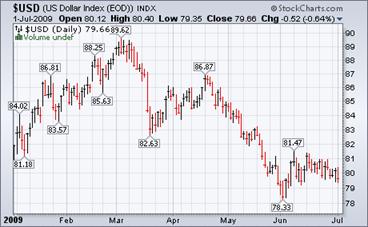 --
-- 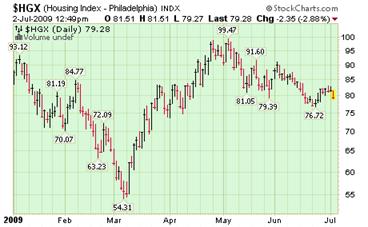
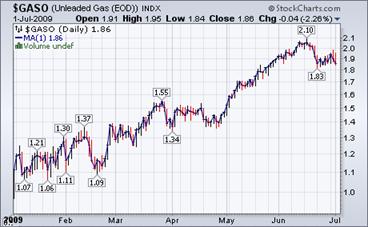 Energy Information Administration Weekly Report suggests that, “Heading into the 4th of July weekend, U.S. drivers are understandably concerned about gasoline prices, which have risen by more than $1 per gallon so far in 2009, and by nearly 60 cents per gallon since the beginning of May. On the other hand, gasoline prices remain well below last summer’s record levels, and actually posted a decrease in the past week. Have we already seen the worst for this year?”
Energy Information Administration Weekly Report suggests that, “Heading into the 4th of July weekend, U.S. drivers are understandably concerned about gasoline prices, which have risen by more than $1 per gallon so far in 2009, and by nearly 60 cents per gallon since the beginning of May. On the other hand, gasoline prices remain well below last summer’s record levels, and actually posted a decrease in the past week. Have we already seen the worst for this year?”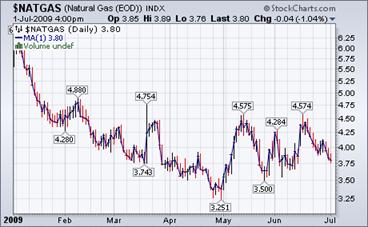 The Energy Information Agency’s Natural Gas Weekly Update reports, “Almost on cue with the official start of summer this week, temperatures in the southern and middle parts of the country soared, likely boosting air-conditioning demand. Although cooling demand represents a major consumption segment in the natural gas industry, in the past week higher demand from electric generation companies seems to have only limited declines in prices. Concerns over the state of the economy and ample supplies continued to dominate the pricing environment.”
The Energy Information Agency’s Natural Gas Weekly Update reports, “Almost on cue with the official start of summer this week, temperatures in the southern and middle parts of the country soared, likely boosting air-conditioning demand. Although cooling demand represents a major consumption segment in the natural gas industry, in the past week higher demand from electric generation companies seems to have only limited declines in prices. Concerns over the state of the economy and ample supplies continued to dominate the pricing environment.” 

